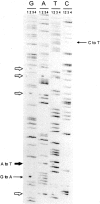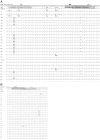Conservation of Epstein-Barr virus cytotoxic T-cell epitopes in posttransplant lymphomas: implications for immune therapy
- PMID: 12000735
- PMCID: PMC1850887
- DOI: 10.1016/S0002-9440(10)61130-3
Conservation of Epstein-Barr virus cytotoxic T-cell epitopes in posttransplant lymphomas: implications for immune therapy
Abstract
Posttransplant lymphoproliferative disease can be treated by the infusion of Epstein-Barr virus-specific cytotoxic T lymphocytes, which were raised against lymphocytes immortalized with a laboratory strain of Epstein-Barr virus (B95.8). Whether the immunodominant epitopes in B95.8 are shared in virus from tumors will affect the general applicability of this therapy. We have characterized the viral strain and the sequence of commonly recognized cytotoxic T-lymphocyte epitopes in 25 posttransplant lymphoproliferative disease specimens from 19 patients. Type A virus was present in 24 of 25 specimens. No variation in two LMP2A epitopes and a few variations mostly outside the targeted epitopes or silent in three EBNA3C epitopes were found, with one variation (Arg to Lys) detected in an EBNA3C epitope in 12 of 24 tumors. However, cytotoxic T lymphocytes to B95-8-derived EBNA3C peptides specifically lysed both B95-8 and the Lys-variant peptide-loaded target cells, although with less efficiency. These results suggest that adoptive immunotherapy using cytotoxic T lymphocytes expanded with B95.8 stimulators or vaccine strategies using B95.8-derived sequence will generally target Epstein-Barr virus strains present in posttransplant lymphoproliferative disease tumors.
Figures





Similar articles
-
An Epstein-Barr virus deletion mutant associated with fatal lymphoproliferative disease unresponsive to therapy with virus-specific CTLs.Blood. 2001 Feb 15;97(4):835-43. doi: 10.1182/blood.v97.4.835. Blood. 2001. PMID: 11159505
-
Sustained CD8+ T-cell immune response to a novel immunodominant HLA-B*0702-associated epitope derived from an Epstein-Barr virus helicase-primase-associated protein.J Med Virol. 2004 Apr;72(4):635-45. doi: 10.1002/jmv.20023. J Med Virol. 2004. PMID: 14981767
-
Cytotoxic T-lymphocyte responses to a polymorphic Epstein-Barr virus epitope identify healthy carriers with coresident viral strains.J Virol. 2000 Feb;74(4):1801-9. doi: 10.1128/jvi.74.4.1801-1809.2000. J Virol. 2000. PMID: 10644353 Free PMC article.
-
Transformation-associated Epstein-Barr virus antigens as targets for immune attack.Ann N Y Acad Sci. 1993 Aug 12;690:86-100. doi: 10.1111/j.1749-6632.1993.tb43999.x. Ann N Y Acad Sci. 1993. PMID: 7690218 Review. No abstract available.
-
Human cytotoxic T lymphocyte responses to Epstein-Barr virus infection.Annu Rev Immunol. 1997;15:405-31. doi: 10.1146/annurev.immunol.15.1.405. Annu Rev Immunol. 1997. PMID: 9143694 Review.
Cited by
-
Ex vivo screening for immunodominant viral epitopes by quantitative real time polymerase chain reaction (qRT-PCR).J Transl Med. 2003 Dec 15;1(1):12. doi: 10.1186/1479-5876-1-12. J Transl Med. 2003. PMID: 14675481 Free PMC article.
-
Genomic variations in EBNA3C of EBV associate with posttransplant lymphoproliferative disorder.JCI Insight. 2020 Mar 26;5(6):e131644. doi: 10.1172/jci.insight.131644. JCI Insight. 2020. PMID: 32213705 Free PMC article.
References
-
- Knowles DM, Cesarman E, Chadburn A, Frizzera G, Chen J, Rose EA, Michler RE: Correlative morphologic and molecular genetic analysis demonstrates three distinct categories of posttransplantation lymphoproliferative disorders. Blood 1995, 85:552-565 - PubMed
-
- Frizzera G, Hanto DW, Gajl-Peczalska KJ, Rosai J, McKenna RW, Sibley RK, Holahan KP, Lindquist LL: Polymorphic diffuse B-cell hyperplasias and lymphomas in renal transplant recipients. Cancer Res 1981, 41:4262-4279 - PubMed
-
- Nalesnik MA: Posttransplantation lymphoproliferative disorders (PTLD): current perspectives. Semin Thorac Cardiovasc Surg 1996, 8:139-148 - PubMed
-
- Chadburn A, Cesarman E, Knowles DM: Molecular pathology of posttransplantation lymphoproliferative disorders. Semin Diagn Pathol 1997, 14:15-26 - PubMed
Publication types
MeSH terms
Substances
Grants and funding
LinkOut - more resources
Full Text Sources
Other Literature Sources
Medical
Molecular Biology Databases

